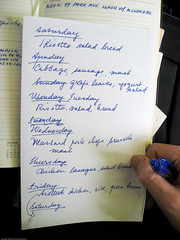Does this sound familiar? It is 5 p.m., and you stop by the grocery store after work. You don’t have much time to make dinner before you have to go to a parent/teacher conference at 7 p.m., so you buy some carrot sticks, a pound of meat, whole wheat buns and sloppy joe mix from a package. Oh, don’t forget a bag of chips. That covers dinner for tonight.
The next night, it is the same story, but this time you have had a really stressful day at work and all you want to do is go home and relax, so you go through the drive through and spend $25 to feed your family of four.
If this sounds familiar and you want to save yourself some time and money, try menu planning.
Life is busy whether you are a stay at home parent or employed full time, whether you have kids or not. A menu plan is the best way to help control the chaos that surrounds dinner time.
The Time Investment
 True, it does take some time to create a menu plan, but you will reap the rewards all week long. In the beginning, you can expect to spend about 30 to 60 minutes once a week picking your recipes and making a grocery list. (The time you spend doing this will lessen as you become more comfortable with the routine and create a repertoire of recipes that you and your family like.)
True, it does take some time to create a menu plan, but you will reap the rewards all week long. In the beginning, you can expect to spend about 30 to 60 minutes once a week picking your recipes and making a grocery list. (The time you spend doing this will lessen as you become more comfortable with the routine and create a repertoire of recipes that you and your family like.)
The Time Payoff
If you go to the grocery store with a list of all the necessary ingredients needed to make your meals for the week, you will be focused. You should be out of the grocery store in 60 minutes or less.
If you operate without a menu plan, it is not unusual to stop by the grocery store (or to go through the drive thru) four to five times a week. If your average stop is about 20 to 30 minutes, you are spending 80 to 150 minutes a week. Having a grocery list and shopping only once a week will save you 20 to 90 minutes a week!
The Financial Payoff
Unless you are extremely disciplined, you make impulse buys when grocery shopping. Let’s say you make three impulse buys each time you shop. If you only enter the grocery store once a week, you are only making 3 impulse buys. If you grocery shop 5 times a week, you will likely make 15 impulse buys. Depending on the price of the unplanned items, you could be spending as much as $15 to $30 and upwards a month by shopping so frequently.
If you make a menu plan and a grocery list, you give yourself time to look through the ads and choose recipes that take advantage of sale items, lowering your grocery bill overall. By contrast, if you stop by the store every night and buy what you “feel” like eating that night or what is convenient to make, you will be spending much more weekly.
Even though it may not be something you do now, hopefully realizing the time and financial payoffs will have you thinking about menu planning. Next time we will explore the mechanics of menu planning.
(B.B. Note: Make sure you come back on Tuesday to read about how to implement a Menu Plan!)
photo credit: See-ming Lee 李思明 SML
Melissa is a writer and virtual assistant. She earned her Master’s from Southern Illinois University, and her Bachelor’s in English from the University of Michigan. When she’s not working, you can find her homeschooling her kids, reading a good book, or cooking. She resides in New York, where she loves the natural beauty of the area.
